Harold Davis's Blog, page 160
April 15, 2015
What do Harold Davis and Georgia O’Keeffe have in common on Pinterest, and how is Pinterest going to make money, anyway?
Actually, I don’t really care how Pinterest plans to make money, although in the light of the rest of this story it is worth noting that Pinterest has a private market value believed to be north of $10 Billion. Yes, that is Billion, as in a ten with nine zeros after it.
In case you’ve been doing your best to ignore social media on the Internet, the idea behind Pinterest is that users create virtual bulletin boards, and then “pin” images that are copied from a variety of sources onto these boards. I haven’t heard any cogent analysis of how this will make money, but I do know that plenty of my images are used this way without my permission…including one photo of a rose that is commonly mistaken for a Georgia O’Keeffe painting
A rose is a rose is a rose, except when it is not. A Harold Davis rose photo is apparently a Georgia O’Keeffe rose painting when you search Google Images for “Georgia O’Keeffe” (opens in a separate window, may be a number of rows down) except when it is actually Kiss from a Rose by Harold Davis (shown below). I’m really pretty flattered by the association, as Georgia O’Keeffe is certainly one of my great artistic heroes.
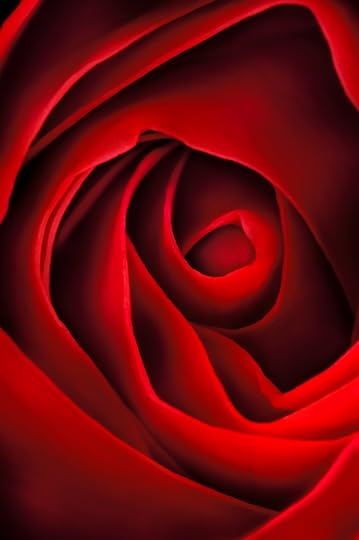
Kiss from a Rose © Harold Davis
I was alerted to my photo made in homage to O’Keeffe being mistaken for a literal O’Keefe by a reader who wrote, “Hi Harold! Love your Rose Photography. I see on Google your work is confused with Georgia O’Keeffe’s paintings!” While this case of mistaken artistic identity mostly involves Kiss from a Rose, some of my other images such as Eye of the Rose and even the book cover for my Photographing Flowers also occasionally show up categorized as O’Keeffe’s.
The conflation of Harold Davis photos with Georgia O’Keeffe paintings get even more pronounced on Pinterest, where a number of “boards” have “pinned” my image as a Georgia O’Keeffe’s. (See www.pinterest.com/terper1234/georgia-o-keeffe/ (my rose is called “a lush red O’Keeffe”), www.pinterest.com/nicolenotch/artist-o-keefe/ (once again my rose is ascribed to O’Keeffe) as examples, although this Pinterest Fakes and Mistakes board notes correctly that “NOT GEORGIA O’KEEFFE >>> this is a photo by Harold Davis”).
I am in fact of two minds about this issue. On the one hand, obviously it is good publicity for me that people like my work enough to pin it on their Pinterest boards. And, as I noted, I am certainly flattered to be compared with O’Keeffe.
On the other hand, it is hard enough to make money as a living artist these days when one is up against the common Internet dogma that information “wants to be free.” Ascribing to this theory across the board leads to a rush to the bottom. As a hint folks: ultimately this means no more quality visual art, literature, or music.
The TOS on Pinterest claims that each user (e.g., someone who creates a board) is responsible for obtaining permission to use work, but of course people just ignore this, and go ahead and scrape imagery off the sites where I post. I doubt anyone at Pinterest really believes that users are going to get permission, and posting this TOS is just el poo-poo del toro to try to ward off copyright lawsuits. Which someone should really do, and take Pinterest to the cleaners for the intellectual property scamsters they are. Or, Pinterest could prove they care about artistic creation by setting up a financial pool to reward artists whose work is used on their site.
What do you think about this? I know that many of my readers are Pinterest users. Am I out to lunch on this one?

April 13, 2015
Digital paintings that use photographs as the medium
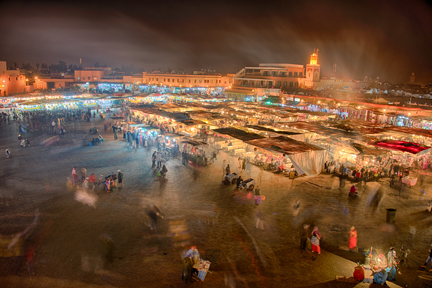
Harold Davis’ talent as a painter is evident in this beautifully rendered photograph of the Jamaa-el-Fnaa marketplace in Marakesh, Morocco. © Harold Davis
Eileen Fritsch, a writer who often covers the visual arts, profiled me recently in relationship to digital printmaking. In her profile, Eileen notes that I regard my work as “digital paintings that use photographs as the medium.” She continues: “With his unique style, Davis is at the forefront of an emerging art movement in which creative photographers can do far more than capture an elusive moment in time. Thanks to Photoshop (which recently celebrated its 25th anniversary), photographic artists such as Harold Davis can now create images that depict almost any type of scene or subject they can envision in their mind’s eye.”
You can read the extensive full article on the Moab Paper blog.
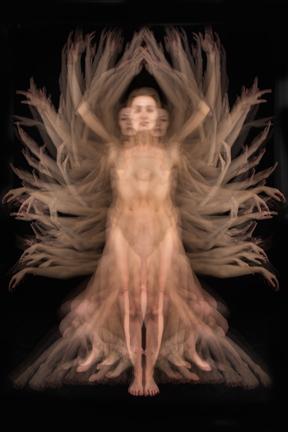
In this multiple exposure image, Harold Davis envisions image “Hekatonkheires” the three mythical Greek gods of violent storms and hurricanes. The artisanal pigment print takes full advantage of the qualities of Moab Slickrock Metallic Pearl 360 paper. Photo: © Harold Davis
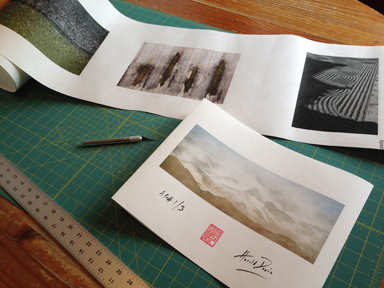
Pages for the Kumano Kodo portfolio are printed on the roll and hand trimmed, scored, signed, and bound. Photo: © Harold Davis

Antoni Gaudi and the shell game
Antoni Gaudi, the architect of the fabulous Sagrada Familia in Barcelona, Catalonia, liked to use organic shapes of nature in his designs. Hence the pillars in the Sagrada Familia cathedral bear a striking resemblance to trees, and the interior of the spires in the church bear the stamp of Gaudi’s life-long fascination with embodying nature in architecture since these spiral stairs resemble the interiors of spiral shells.

Inside the Sagrada Familia Spire © Harold Davis
You’ll see what I mean if you check out the interior and exterior views of this spiral shell of the Architectonica genus, shown below, and compare with the Sagrada Familia spiral.

Architectonica Spiral (inward) © Harold Davis
Check out the macro photo shot straight up and through the Architectonica, and compare with the view inside the Sagrada Familia spire at the bottom of this story:

Architectonica Spiral (outward) © Harold Davis
If you are curious, here’s the way the Architectonica shell spiral looks from the outside:

Architectonica Spiral © Harold Davis
Incidentally, the views inside the Sagrada Familia spire shown at the top of this story and below were shot hand-held at ISO 51,200. You can read the related blog story to see why this was my best technical choice in the circumstances, and the only way to get a photo in the location—and an approach that would not have been feasible even a few short years ago.

Inside the Sagrada Familia Spire (looking up) © Harold Davis

April 11, 2015
We are not afraid of color
I photographed these flowers on my light box using the bright and sharp Zeiss Otus 85mm lens, then created a number of variations in Photoshop. The colors in flowers give me a palette to experiment with saturation and contrast, and I herewith proclaim: Bring it on! I love color!
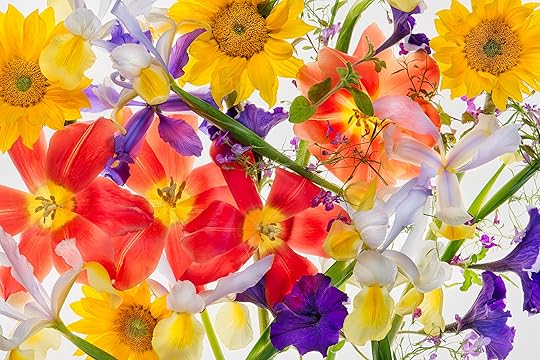
We are not afraid of color © Harold Davis

Patterns in the Zeitgeist © Harold Davis

Flowers are the jungle © Harold Davis

Beyond the blue light © Harold Davis
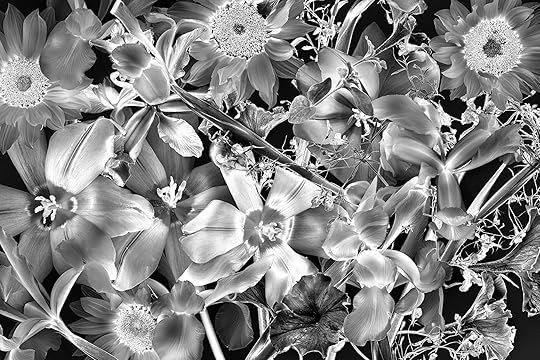
Solarized Flowers © Harold Davis
If you are interested in my flower photography techniques both in the camera and in post-production, there are still a few spots left in my Creative Flower Photography workshop at Maine Media in Rockport, Maine this coming August (2015). This is a five-day workshop that will cover light box photography, creative field flower photography, and Photoshop techniques.
Related story: An Amazing Amalgamation of Anemones.

April 10, 2015
Waterlogue and Harold Davis iPhoneography
The best camera to use is the one you have with you, and I pretty much always have my iPhone camera with me. My iPhone is not only a camera, it is also a digital darkroom. Please click here to check out my new virtual gallery of iPhoneography by Harold Davis.
So, carpenters know to get the right tool for the job. If I need a high resolution original to make big prints I am likely to use a 36MP full-frame DSLR with one of my superb Zeiss lenses.
But for quick, impressionistic water-color-like images, such as the ones shown here, my iPhone and the Waterlogue app are just the ticket! Waterlogue is certainly not the only iPhone processing app I use, but it is my go-to software when I am looking for a soft, dreamy water color look.
I shot this image at Monet’s Garden, Giverny, about an hour outside of Paris. I used my iPhone camera app. I used my bracket to place the iPhone on my tripod, and the ear bud as a shutter release. On the bus ride back to Paris, I processed the image on my phone using the nifty Waterlogue app.

Giverny © Harold Davis
Today the city of Cahors in the southwest of France is a slightly gritty provincial capital—but back in the middle ages it was fabulously wealthy. Protected on three sides by the river Lot, Cahors was nevertheless sacked, abandoned and rebuilt. But glory was never regained entirely (the Black Death didn’t help matters). You can see the remnants in the palaces and monuments of the old quarter, where today they have a wonderful fresh food market. I got my lunch today in this market. You really can’t beat a fresh loaf of bread, a tranche of locally made pate, strawberries and a tomato!
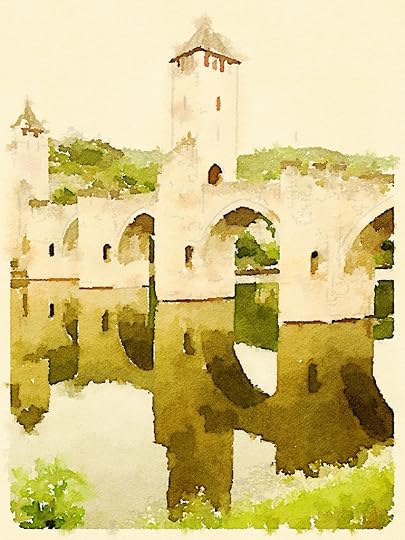
Pont Valentre Waterlogue © Harold Davis
Cahors may have fallen to brute force and treachery during the hundred years war during the convoluted battles between French and English monarchs, but the Pont Valentre, shown above and below via iPhone capture, was rightly regarded as impregnable.
Over the years, I have photographed the beached and slowly decaying Point Reyes trawler, located near Inverness, California, by starlight and by daylight in the afternoon. This photo was by iPhone, made while my boys clambered over the wrecked vessel.

Point Reyes Boat © Harold Davis
Photographed on my iPhone, and processed on my phone on the spot with the nifty Waterlogue app. Here’s another one:
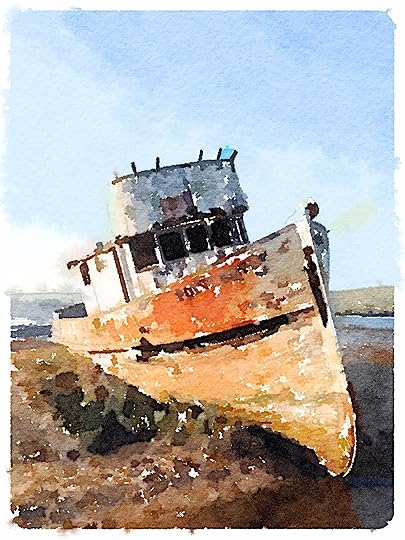
Point Reyes Boat 2 © Harold Davis
The Royal Air Maroc plane to Lisbon was late to leave, as expected. Still, it was a relief to leave the chaos of Casablanca as we said goodbye to Morocco. Surely an adventure with many images to process, and much to digest. I captured this image on my iPhone, and processed it with Waterlogue.

Leaving Morocco © Harold Davis

San Francisco Dreams in Black and White
San Francisco dreams in black and white. Please come visit my new virtual gallery of San Francisco in Black and White!

Noir City Dreams © Harold Davis
What goes on behind the shades in the lit window of an anonymous apartment in the big city? Meanwhile, the moon rises over the proverbial skyline.

San Francisco Moonrise © Harold Davis

April 8, 2015
Tulips in a Glass Vase
To make this image, I placed the vase of tulips on a mirror, and lit the vase and flowers from behind with a standing light box. This is the same setup and technique I used in the images shown in HDR is technique, not style. You can see the setup and get an idea about the processing from the spread on pages 128-131 of Creating HDR Photos.

Tulips in a Glass Vase © Harold Davis
I also experimented with a simulated, virtual solarization of the image, converted to black & white, shown below.
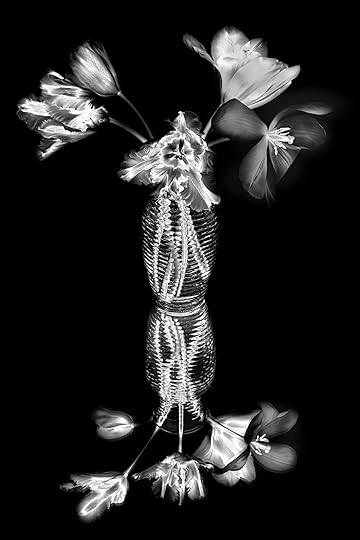
Tulips in a Glass Vase – Solarized © Harold Davis

April 7, 2015
Letter about my photo trip to Italy in the autumn
Dear fellow photographers:
My name is Harold Davis, and I am an artist, photographer, writer, and teacher. If you are not familiar with my photography books, please check out my page on Amazon.
I am offering a unique opportunity to join me and a very small group photographing Italy this autumn (the dates are October 28 – November 11, 2015). If you are tired of being part of the photographic herd, then this is the trip for you! The group size is strictly limited to six participants.
 We will be photographing in Cinque Terre, Naples, the island of Capri, and in Positano and the Amalfi coast. Accommodations, transportation, and many meals are included. I will be working with a top-flight local Italian licensed tour guide with an art history background to make sure that we have the best experience possible. The cost is $6,495 per person. Please see www.digitalfieldguide.com/learning/workshops-events/italy for full details.
We will be photographing in Cinque Terre, Naples, the island of Capri, and in Positano and the Amalfi coast. Accommodations, transportation, and many meals are included. I will be working with a top-flight local Italian licensed tour guide with an art history background to make sure that we have the best experience possible. The cost is $6,495 per person. Please see www.digitalfieldguide.com/learning/workshops-events/italy for full details.
As a workshop leader, my goal is to is to facilitate a community of photographers, have fun photographing in interesting and exciting places, share some technical information, and—most importantly—encourage each participant’s unique and individual creative expression. As one of my workshop participants has put it, “Harold is genuine, generous, and gracious. He has a world of knowledge and expertise that he loves to share. His wonderful books show his monumental talents and skill set, and his workshops show the depth of his connecting with others in a very real and personal way.”
Please join me in Italy this autumn. I look forward to working with you one-on-one in exciting locations to realize your photography dreams and goals.
Let me know if you have any questions.
Harold Davis

April 6, 2015
Arms

Arms © Harold Davis
Four in-camera exposures, with the model stationary besides her arms. Related stories: Pagan Goddess, Multiple Exposures.
Shadows
In this image, I used my iPhone to photograph and process the shadows of a Venetian blind projected by the late afternoon sun onto the linen curtains in my office. Note the shadow of the rectangular pole (used to open and close the slats) in the lower right, and the regular pattern of darker shadow at the apex of the curve made by the positioning of the curtains.

Shadows © Harold Davis
While it is great to travel with my camera, I believe—and I like to teach—that it is perfectly possible to be creative wherever you are, and that sometimes home is best.



